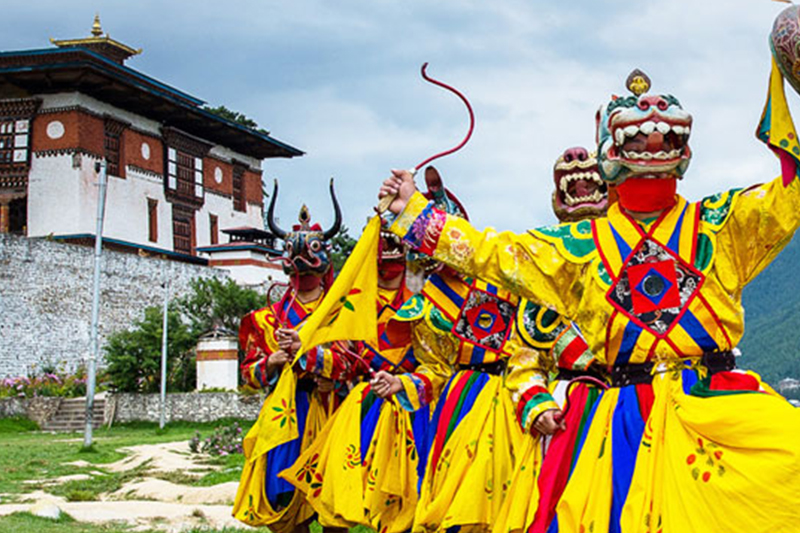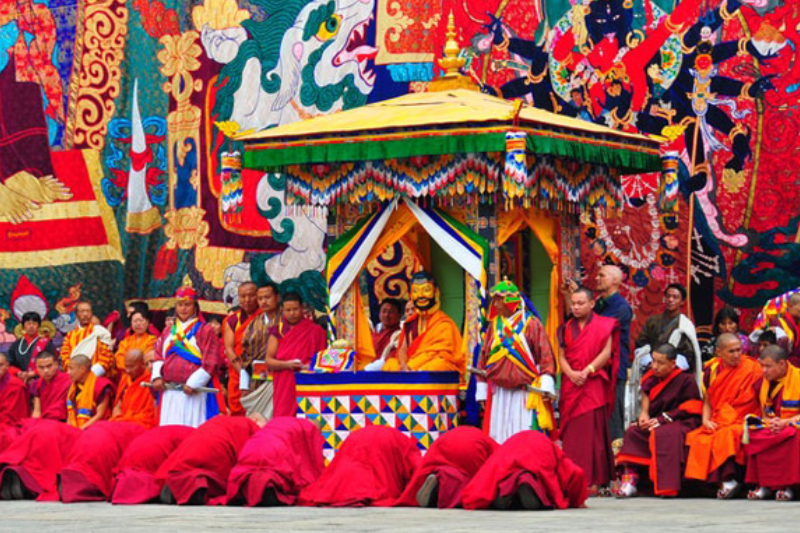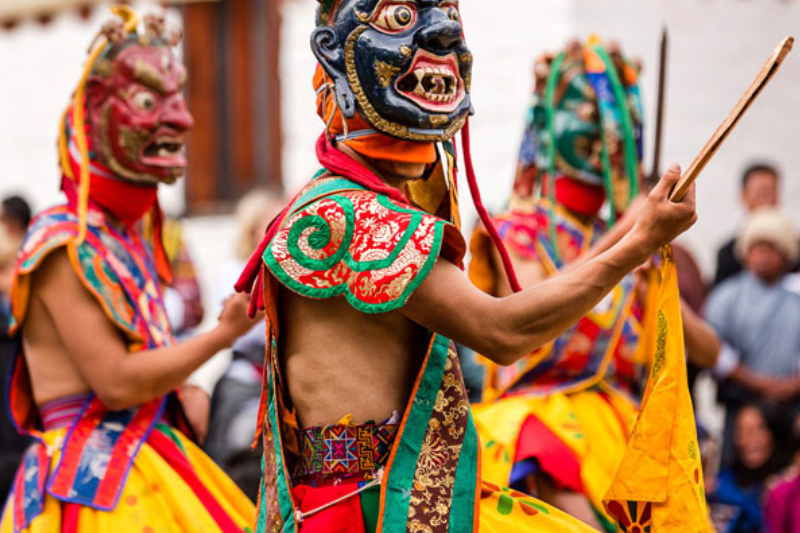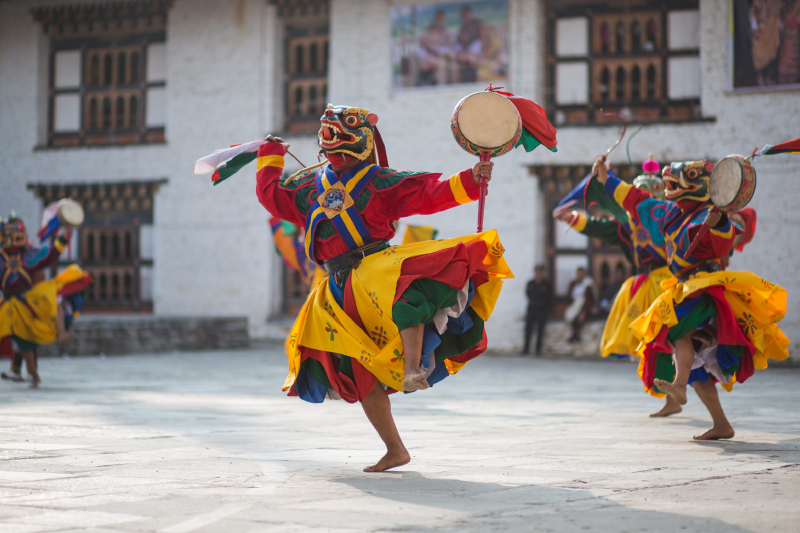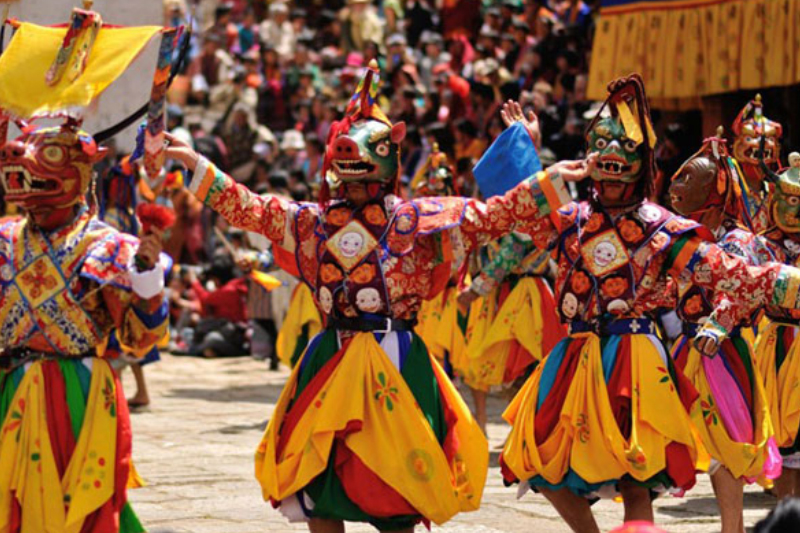East Bhutan Gomkora Festival Tours
Trip Overview of East Bhutan Gomkora Festival Tours
Gomkora Festival is the small temple in the East Bhutan and its correct name is Gomphu Kora. Gomphu means the sacred meditation site of Guru Padmasamva and Kora means circumambulation. The Guru meditated here and left a body impression on the rock.
Detail itinerary of East Bhutan Gomkora Festival Tours
-
DAY 1
ARRIVE PARO
During the journey, the traveler will experience from the left side of the plane a spectacular view of Mt. Everest, and other famous Himalayan Mountains including the sacred Mt. Jhomolhari and Mt. Jichu Drake in Bhutan. On arrival at Paro International Airport you will be received by your Bhutanese friend from Bhutan Bigfoot Trekkers (Tours). Lunch at the Hotel. Discuss the Tour Programme with the Tour Guide. After lunch, drive to the ruins of the Drukgyal Dzong, built in 1647 by the Great Shabdrung Ngawang Namgyal, father and unifier of medieval Bhutan, the dzong was destroyed by accidental fire and left in ruins as an evocative reminder of the great victories it was built to commemorate. Explore the ramparts and on a clear day experience an unforgettable view of Mt. Jhomolhari (7,314 m). On the way back, visit Kichu Lhakhang, built in 659 A.D by the Tibetan king Srongsen Gampo. This Monastery is one of the 108 monasteries built across the Himalayan region by the Tibetan King to subdue the Demons that lay across the Himalayan region. Over night: Hotel in Paro.
-
DAY 2
Day 02. PARO A DAY EXCURSION TO TAKTSANG MONASTERY
After breakfast a short drive takes us to Satsam Chorten, the trail climbs through beautiful pine forest, many of the trees festooned with Spanish moss, and an occasional grove of fluttering prayer flags. We stop for a rest and light refreshments at the Taktsang Jakhang (cafeteria) and then walk a short distance until we see, clearly and seemingly within reach, Taktsang monastery. The primary Lhakhang was built around Guru Rimpoche's meditation cave in 1684 by the Penlop of Paro, Gyaltse Tenzin Rabgay, this incredible monastery clings to the edge of a sheer rock cliff that plunges 900 meters into the valley below. Legend has it that Guru Padmasambhava, the tantric mystic who brought Buddhism to Bhutan in 747 AD, flew here on the back of a flying tiger, Dorji Drolo, said to be his favorite consort. After lunch, visit Ta Dzong (built in1656 and renovated in 1968), an ancient watchtower, which now houses the National Museum. Below the museum is the Rimpung Dzong (literally meaning Heap of Jewels), the centre of civil and religious authority in this valley, built in 1646 by Shabdrung Ngawang Namgyal. In the evening, drive to Thimphu. Over night: Hotel in Thimphu.
-
DAY 3
PARO - THIMPHU / SIGHT SEEING
After breakfast, visit to the National Memorial Chorten (1974) built in honor of our late King Jigme Dorji Wangchuk and the Dupthop Lhakhang one of the few surviving nunneries in Bhutan. We then visit the National Library, stocked with ancient Buddhist manuscripts, and the Painting School where traditional art is still kept alive through instructions in the art of painting Thangkas (sacred Buddhist religious scrolls). After lunch, scroll around the Sunday Market to see the Bhutanese way of life and witness the Archery Tournament, the National Game of Bhutan. In the evening visit the mini zoo at Motithang and drive to Sangaygang view point where you can get the spectacular view of the Capital city. Over night: Hotel in Thimphu.
-
DAY 4
THIMPHU - PUNAKHA: (72 Kms, 3 hours drive)
After breakfast, drive to Punakha via Dochula pass. If the weather is clear, we stop for a while at Dochula pass to view Higher Himalayas. On the way, stop a while to view Chimi Lhakhang, which was built by Lama Drukpa Kuenley in 15th century. He subdued the demons with his Magical Thunder bolt. The Temple is also known as the Temple of Fertility. Lunch at Punakha. After lunch, visit Punakha Dzong built in 1637 by Shabdrung Ngawang Namgyal and is situated between Pho Chu (Male river) and Mo Chu (Female river). For many years until the time of the second king, it served as the seat of the Government. The construction of the Dzong was foretold by Guru Rimpoche, who predicted, a person named Namgyal will arrive at a hill that looks like an elephant. There was a smaller building here called Dzong Chu (Small Dzong) that housed a statue of Buddha. It is said that Shabdrung ordered the architect, Zowe Palep, to sleep in front of the statue, while Palep was sleeping, the Shabdrung took him in his dreams to Zangtopelri and showed him the palace of Guru Rimpoche. From his vision, the architect conceived the design for the new Dzong, which in keeping with the tradition, was never committed to paper. The Dzong was named Druk Pungthang Dechen Phodrang (Palace of Great Happiness). The war materials captured during the battle with Tibetans are preserved here. Punakha is still the winter residence of Je-Khenpo and King Jigme Dorji Wangchuk convened the new national Assembly here in 1952. In the evening, hike to Khamsung Yulley Namgyal Choling Monastery. Over night: Hotel in Punakha.
-
DAY 5
PUNDAKHA - GANGTEY VALLEY
After breakfast drive to the beautiful valley of Gangtey. Enroute sightseeing in the valley of Wangdiphodrang includes: visit to Wangdiphodrang Dzong built in 1638. Legend relates that as the people were searching for the site of the Dzong, four ravens were seen flying away in four directions. This was considered auspicious sign, representing the spread of religion to the four points of the compass. The Dzong is situated at the confluence of Mo Chu and Tang Chu rivers. Drive further to Gangtey. On arrival check in to Gangtey Gompa House. Visit Gangtey Gompa Monastery, from outside. Gyaltse Pema Thinley, the grandson and mind reincarnation of Pema Lingpa founded the Temple in 1613, and Tenzin Legpai Dhendup, the second re-incarnation, built the temple. The present Abbot, Kunzang Pema Namgyal is the ninth re-incarnation. It is a Nyingmapa monastery and is affiliated to other Nyingmapa monasteries including Tamshing in Bumthang. Explore Phobjikha valley, famous for the Black Necked Cranes during winter. Over night: Guest House or hotel in Gangtey valley.
-
DAY 6
GANGTEY VALLEY - TRAONGSA - BUMTHANG
After breakfast, drive to Bumthang. Visit Trongsa Dzong on the way, the most impressive dzong of Bhutan, built in its present form in 1644 by Chogyal Minjur Tempa, the official who was sent by Shabdrung to unify eastern Bhutan and enlarged at the end of the 17th century by Desi Tenzin Rabgay. Trongsa Dzong is the ancestral home of the present Royal Family and first two hereditary kings ruled Bhutan from this Dzong. Then Visit Ta Dzong, an ancient watch tower. The chapel inside the Ta Dzong is said to be dedicated to the Trongsa Penlop Jigme Namgyal. After Lunch, drive to Bumthang. Over night: Hotel in Bumthang.
-
DAY 7
BUMTHANG SIGHT SEEING
After breakfast, visit Jakar Dzong, which literally means The Castle of White Birds. The current structure was built in 1667 and then visit Lamey Goemba, a large palace and monastery built in 18th century by Dasho Phuntsho Wangdi. Visit Jambay Lhakhang, built by King Srongsen Gampo of Tibet in the year 659 on the same day as Kichu Lhakhang in Paro. The temple was visited by Guru Rimpoche during his visit to Bumthang and was renovated by Sindhu Raja after Guru Rimpoche restored his life force. Under the temple is said to be a lake in which Guru Rimpoche hid several Terma. In October one of the most spectacular festival, Jambay Lhakhang Drup is staged here. After lunch, Visit Chakhar (Iron Castle) Lhakhang, it is the site of the palace of the Indian King, the Sindhu Raja who invited Guru Rimpoche to Bumthang. The Original palace was made of Iron and hence the name Chakhar. The saint Dorji Lingpa built the Current building in 14th century. Its correct name is Dechen Phodrang. We then visit Kurjey Lhakhang that is named after body print of Guru Rimpoche, built in 1652 by Minjur Tempa. Visit Tamshing Lhakhang (Temple of the good message), established in 1501 by Pema Lingpa and is the most important Nyingmapa temple in the kingdom. In the evening, visit Membarstho which literally means, The burning Lake. Over night: Hotel in Bumthang.
-
DAY 8
A day excursion to Ura valley & back to Bumthang
After breakfast, Excursion to the beautiful valley of Ura valley. Over night: Hotel in Bumthang.
-
DAY 9
Bumthang--Mongar
After breakfast drive to Mongar. Packed lunch will be served on the way. There you can see the typical Bhutanese farm houses. Over night: Hotel in Mongar.
-
DAY 10
MONGAR - TRASHIGANG (3hrs drive)
After breakfast, visit Mongar Dzong. This Dzong was rebuilt in 1953 and is quite small. There are around 50 to 60 monks in the Dzong, many of them young boys eight to ten years old. The image in the Dzong are of Buddha and as well as of Guru Rimpoche (One who brought Buddhism in Bhutan) and drive further to Trashigang. On the way to Trashigang, we have to cross over Korila Pass. After lunch, witness the Festival. Over night: Camping.
-
DAY 11
TRASHIGANG A DAY EXCURSION TO KHALING TRASHIYANGTSE
After breakfast drive to Khaling where you will get to visit the traditional handloom (The handloom was established by the National Women Association of Bhutan (NGO) to encourage the women to keep alive the production of traditional dress). The first College of Bhutan (Kanglung College) is also located here. After lunch hike to villages in Khaling where you will get to know more of Bhutanese culture especially of the Eastern Bhutan and their way of living. Over night: Camping (Trashiyangtse).
-
DAY 12
TRASHIYANGTSE - GOMKORA
Early Morning drive to drive to Gom Kora. It is the small temple in the east and its correct name is Gomphu Kora. Gomphu means the sacred meditation site of Guru Padmasamva and Kora means circumambulation. The Guru meditated here and left a body impression on the rock. Over night: Camping (Trashiyangtse).
-
DAY 13
TRASHIYANGTSE - GOMKORA
Early Morning drive to drive to Gom Kora. It is the small temple in the east and its correct name is Gomphu Kora. Gomphu means the sacred meditation site of Guru Padmasamva and Kora means circumambulation. The Guru meditated here and left a body impression on the rock. Over night: Camping (Trashiyangtse).
-
DAY 14
TRASHIYANGTSE - TRASHIGANG (4 hrs drive)
Attend the festival in the morning. After lunch drive Trashigang. Over night: Hotel in Trashigang.
-
DAY 15
MONGAR - BUMTHANG (7hrs drive)
After breakfast, drive to Bumthang. Packed lunch will be served on the way. If you have time in the evening visit the Wangdicholing Palace (the old ruined Palace), the residence for the 1st and 2nd Kings. In the evening, stroll in the town. Dinner and over night in a Farm House to see the Bhutanese way of Life.
-
DAY 16
BUMTHANG - THIMPHU (9 hrs drive)
Early breakfast, drive to Thimphu. In the evening visit to the Handicraft shops. Over night: Hotel in Thimphu.
-
DAY 17
THIMPHU - PARO INTERNATIONAL AIRPORT for departure
Early morning drive to Paro International Airport and your Bhutanese friends from Bhutan Bigfoot Trekkers will accompany you to bid farewell as you embark on your onward journey to back home. "You May Cotomize the Tour As per your Need & Desire"
Cost includes and excludes
Check the cost inclusion and exclucion of East Bhutan Gomkora Festival Tours
Service Includes
- Accommodation with all meals (Breakfast, Lunch and Dinner).
- All transportation by private vehicle.
- Sightseeing tour with English speaking Guide as per itinerary including entry fee to museum.
- Royalties and other taxes. Other than departure tax Bhutan entry visa fee US$ 20 and US$ 10.
Service Excludes
- Airfares (Kathmandu to Paro, Calcutta to Paro, Dhaka to Paro, Delhi to Paro and Bangkok to Paro for one way and double for round trip flight by Druk Airlines.
- Bhutan entry visa fees US$ 20, Paro airport tax US$ 10 & US$ 10 for TDF.
- Hard and soft drinks during the trip.
- Surcharge, Insurance, Personal expense and Tips

